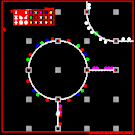
Trane is a collective, algorithmic composition environment. It is also a toy. By laying out tracks, setting down notes, and distributing trains, users create a rail network that doubles as a musical composition.
There are 128 * 128 switches or roundhouses, each with four possible points of redistribution, which can be interactively redefined allowing for varying movements. For example, a series of four curved tracks could be placed in a circle, with the switches oriented to always send the train in the same direction (clockwise or counter-clockwise). By placing trains and notes on this circle, a constant looping rhythm or melody could be created. A second set of tracks could then be attached to this circle, allowing for variable offshoots and thereby modulating the monotony of the looping circle. As more and more alternative routes are drawn, each with their own set of notes, infinitely varying, generative music becomes possible.
A downloadable version is also available online for DJs, performers, or people simply wishing to compose private diagrams with trane. As the music is standard MIDI output, many electronic music devices can be connected to trane’s output. DJs can connect up synthesizers, MAX/MSP patches, video samplers, etc. and compose a performance in real-time with sounds other than the simple MIDI instruments played through Quicktime.
//////////////////////////////////////////////////
Trane is one of the first components of a larger ongoing project entitled The Abstract Machine. Trane is a collective, algorithmic composition environment. It is also a toy. By laying out tracks, setting down notes, and distributing trains, users create a rail network that doubles as a musical composition.
As the music is standard MIDI output, many electronic music devices can be connected to trane’s output. DJs can connect up synthesizers, MAX/MSP patches, video samplers, etc. and compose a performance in real-time with sounds other than the simple MIDI instruments played through Quicktime. For example, I’ve created a live composition performance entitled “from A to G”, in which the Hitchcock film Strangers on a Train is re-edited in real-time using video and audio clips in the place of notes.
